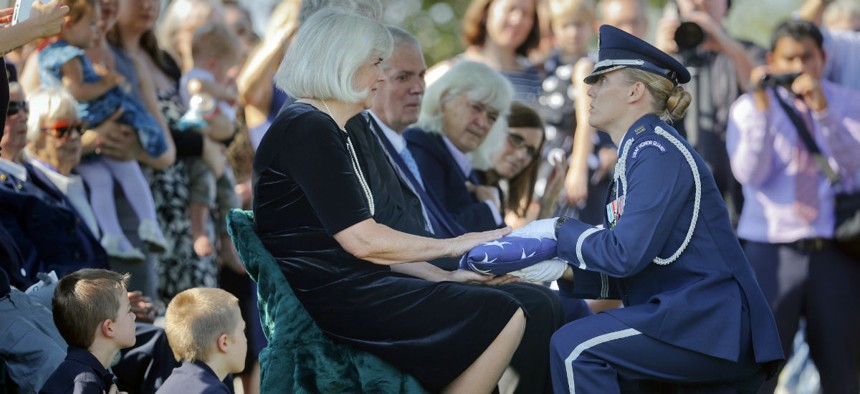
Air Force Capt. Jennifer Lee presents an American flag to Terry Harmon, daughter of World War II pilot Elaine Danforth Harmon, during burial services Wednesday. Pablo Martinez Monsivais/AP
A Woman Pilot Receives the Military Funeral the Army Denied Her
After a years-long battle for recognition, Elaine Harmon, a member of the Women Airforce Service Pilots, was interred at Arlington National Cemetery on Wednesday.
Arlington National Cemetery added another name to its somber roster Wednesday. Elaine Harmon was a member of the Women Airforce Service Pilots during World War II. Thanks to the passage of legislation this summer that allows for the interment of the WASP in Arlington National Cemetery she rests among others who were willing to risk it all for their nation. Just three WASP escorted Harmon to her final resting place. Only 96 remain of the 1,830 who trained and 1,102 who earned their wings; the youngest of them will turn 94 next year.
The WASP flew for the Army Air Forces from 1942 to 1944. They did what their leader Jacqueline Cochran called “aerial dishwashing,” executing jobs that no one wanted to do but needed to be done. They ferried desperately needed aircraft across the country, towed targets behind their planes to train male gunners (who fired at them with live ammunition), flew non-flying personnel, test-flew damaged and repaired aircraft, and did any other flying job the Army Air Forces asked them to do. They were unceremoniously sent home in December 1944 when, after an ugly battle, Congress failed to formally bring them into the USAAF.
A college graduate, as most of the WASP were, Harmon earned her pilot’s license through the government’s Civilian Pilot Training Program before the war began. But not everyone accepted her decision to fly. Harmon’s mother worried what the neighbors would think—it was very unladylike to fly airplanes. When Harmon’s husband was about to be shipped overseas, he thought joining the WASP would keep her too busy to worry. Despite the fact that her mother disapproved, Harmon joined the WASP so she could fly the greatest airplanes in her generation and help bring her husband home. After six months of training, she flew BT-13s at Nellis Air Force Base until the women were disbanded in time for Christmas 1944. She worked as an air traffic controller until her husband came home from the war, and together they moved on with their lives.
When the U.S. Air Force became an independent branch in 1947 they sent letters to the WASP inviting them to join the reserves. The USAF wasn’t interested in having women as pilots despite their experience, but Harmon jumped at the chance to serve her country again. Shortly after the birth of her third child, she was disappointed to receive the letter that became familiar to many of the WASP: The USAF did not allow women to serve if they had children under the age of 14. Men with young children continued to serve.
The women of the WASP began to reconnect with one another in the late 1960s and 1970s as many of them were beginning to retire. In 1972, the Armed Forces announced that for “the first time ever” women would be flying American military aircraft. The WASP realized they had been forgotten and were determined to do something about it. Harmon joined the fight to prove that they were veterans. She typed letter after letter and spoke with lawmakers during the multi-year effort. Not long after the WASP’s 1977 victory recognizing their service as having been active duty, Harmon and a handful of others realized the bill had been written in a limiting way. It said they were veterans for the purposes of the Veterans Administration, meaning those who served in the reserves or the civil service were not allowed to count their time in the WASP toward retirement. In 1977, the women of the WASP rallied together to gain recognition for their work during the war and for the 38 WASP who had died serving their country. In 1981, Harmon testified with Senator Barry Goldwater, the original bill sponsor, that the intention of the law had been lost. But times had changed by the 1980s, and Congress rejected their argument.
In 2009, supporters of the WASP pushed to honor them for their service during the war. Harmon stood behind President Obama as he signed a bill awarding the Congressional Gold Medal to the WASP. She beamed at the 2010 ceremony, reveling in the fact that the WASP were being recognized. The nation was finally remembering them.
As she entered her 90s Harmon’s health began to fail, and she died in April 2015. Her final wish was to be placed at Arlington National Cemetery. As recently as 2002 the cemetery had determined that the women were eligible for ceremonies as officers, but that was reversed in 2015. While the Veterans Administration runs most military cemeteries, the Secretary of the Army runs Arlington National Cemetery. The WASP’s 1977 legislation said they were veterans for the purposes of the Veterans Administration. The Secretary of the Army refused Harmon and other WASP’s requests to be interred at the cemetery based on this technicality.
Harmon’s family was crushed and dismayed by Arlington’s refusal. Then they became determined. They set up a Change.org petition in January calling for their inclusion and gathered over 178,000 signatures. In addition to media coverage, politicians also joined in, giving their fight even more traction. Representative Martha McSally, a USAF veteran pilot and friend of the WASP, introduced a bill in the House. It was replicated by Senator Barbara MiKulski, long-time WASP supporter from Harmon’s home state of Maryland. Both bills gained co-sponsors as fast as they could sign on. After 20 whirlwind weeks, the WASP had a new bill signed by Obama—this one giving them express permission to be interred at Arlington National Cemetery.
Elaine Harmon was my first oral history interview back in 1996. She and I saw each other three or four times a year and she was always sure to share a laugh and a new story or two. She was popular among the WASP for her kind-hearted, adventurous spirit. From bungee jumping in her 80s to sharing laughs with the leader of the free world, Harmon never stopped living her life to its fullest. It is appropriate that she represents the final fight for respect for the WASP. She spent much of her last 40 years working to make sure they were not forgotten. She played a key role in them gaining recognition as veterans in the 1970s and then went on to represent the women at events around the world. She spoke to hundreds of groups over the years, teaching them about the WASP and their part in World War II. And now she is a part of this final lesson: The WASP are veterans.






